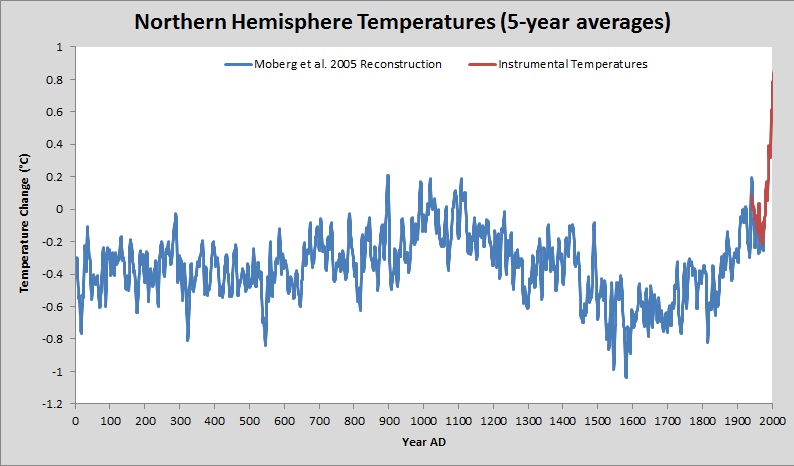Medieval Warm Period: rhetoric vs science
Posted on 23 August 2010 by robert way
One of the most often cited arguments of those skeptical of global warming is that the Medieval Warm Period (800-1200 AD) was as warm as or warmer than today. Using this as proof to say that we cannot be causing current warming is a faulty notion based upon rhetoric rather than science. So what are the holes in this line of thinking?
Firstly, evidence suggests that the Medieval Warm Period was in fact warmer than today in many parts of the globe such as in the North Atlantic. This warming thereby allowed Vikings to travel further north than had been previously possible because of reductions in sea ice and land ice in the Arctic. However, evidence also suggests that some places were very much cooler than today including the tropical pacific. All in all, when the warm places are averaged out with the cool places, it becomes clear that the overall warmth was likely similar to early to mid 20th century warming. Since that early century warming, temperatures have risen well-beyond those achieved during the Medieval Warm Period across most of the Globe. This has been confirmed by the National Academy of Sciences Report on Climate Reconstructions. Further evidence (Figure 1) suggests that even in the Northern Hemisphere where the Medieval Warm Period was the most visible, temperatures are now beyond those experienced during Medieval times.
Secondly, the Medieval Warm Period has known causes which explain both the scale of the warmth and the pattern. It has now become clear to scientists that the Medieval Warm Period occurred during a time which had higher than average solar radiation and less volcanic activity (both resulting in warming). New evidence is also suggesting that changes in ocean circulation patterns played a very important role in bringing warmer seawater into the North Atlantic This explains much of the extraordinary warmth in that region. These causes of warming contrast significantly with today's warming, which we know cannot be caused by the same mechanisms.
Overall, our conclusions are:
a) Globally temperatures are warmer than they have been during the last 2000 years, and
b) the causes of Medieval warming are not the same as those causing late 20th century warming.

Figure 1: Northern Hemisphere Temperature Reconstruction by Moberg et al. (2005) shown in blue, Instrumental Temperatures from Hadley shown in Red.
Note: This post is the Basic version (written by Robert Way) of the skeptic argument "Medieval Warm Period was warmer". We're currently going through the process of writing plain English versions of all the rebuttals to skeptic arguments. It's a big task but many hands make light work. If you're interested in helping with this effort, please contact me.































 Arguments
Arguments























 0
0  0
0 Figure 2: Loehle 2008 temperature reconstruction with Hadley instrumental record.
Aside from that, the Loehle reconstruction is really only a northern-hemisphere reconstruction (only a handful of SH proxies were included, as discussed by chris in this comment). If you compare current NH temperatures to Loehle's reconstruction, things are quite a bit warmer now than at any previous time.
Figure 2: Loehle 2008 temperature reconstruction with Hadley instrumental record.
Aside from that, the Loehle reconstruction is really only a northern-hemisphere reconstruction (only a handful of SH proxies were included, as discussed by chris in this comment). If you compare current NH temperatures to Loehle's reconstruction, things are quite a bit warmer now than at any previous time.
 Click for full size
Moberg's data ended in 1979. Tacked on to the end is GISSTemp from that point forward (red), adjusted slightly down to merge.
This really puts the MWP and LIA into perspective: Yes, there is an underlying long term 'natural cycle', with an apparent period of 1100 years. And yes, we started on the long, gradual upswing after 1650 or so. But the graph of temperature anomalies from 1850-2009 looks nothing like the natural cycle.
That's a difference many seem to forget: the big-picture rate of change of recent temperature anomalies is much too fast to be 'natural'.
Click for full size
Moberg's data ended in 1979. Tacked on to the end is GISSTemp from that point forward (red), adjusted slightly down to merge.
This really puts the MWP and LIA into perspective: Yes, there is an underlying long term 'natural cycle', with an apparent period of 1100 years. And yes, we started on the long, gradual upswing after 1650 or so. But the graph of temperature anomalies from 1850-2009 looks nothing like the natural cycle.
That's a difference many seem to forget: the big-picture rate of change of recent temperature anomalies is much too fast to be 'natural'.







Comments